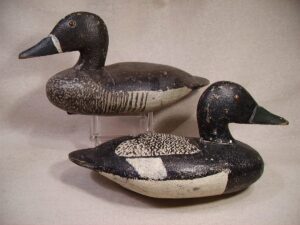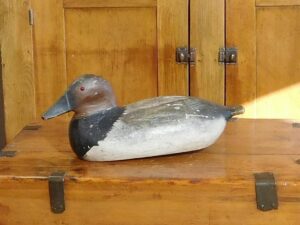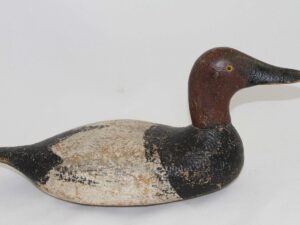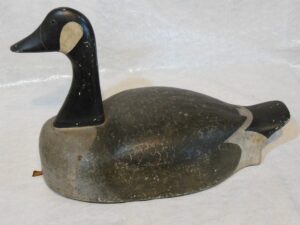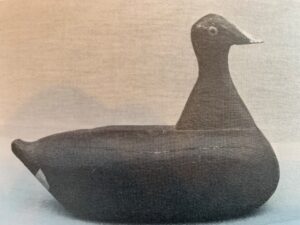A Decoy Corner Article
By Bruce Urben, WWA President
Images courtesy Wisconsin Sporting Collectibles
In November I began highlighting the vintage decoy carvers of Lake Puckaway in Green Lake and Marquette Counties. These men were experts in designing and carving working decoys that served their hunting needs as well as their “sports” that visited their waterfowling hotbed of Wisconsin. These men were farmers, hunting guides, professionals and general laborers who hunted, fished and trapped to feed their families in the early 1900’s.
Here are a few more Lake Puckaway Decoy carvers:
John “Fuzzy” Manthey
John was born in 1890 and lived most of his life in Princeton, WI, just north of Lake Puckaway. He began carving when he was in his 30’s. John hunted Lake Puckaway almost exclusively. He carved solid wood decoys using only hand tools. He is best known for his canvasback, bluebill, ringneck and goldeneye decoys. His carving can be defined as relatively primitive with simple paint schemes. He used tack eyes in his early carving and imported glass eyes later in his carving career. John passed away in 1974 at the age of 84.
George Saurbreite
George was born in 1884 and lived near Princeton. He was a lock tender on the Fox River at Princeton. George was the son of the caretaker of the “CawCaw” duck club on Lake Puckaway. He grew up on the marsh and served as a skiff “pusher” and guide for the members of the Club. George carved hundreds of decoys for his own use, as well as use at the CawCaw Club. George was himself a market hunter on Lake Puckaway, shipping his harvested waterfowl to Chicago, Milwaukee and New York. He was also a skilled boat builder, building more than 30 hunting skiffs, paddles and marsh skis. Saurbreit carved canvasback, bluebills, coot and teal. His sleeping teal decoys are quite valuable to collectors. Most of his solid decoys have low necks and resting poses. He used a very distinctive paint scheme on his canvasbacks and bluebills and most of his decoys have full bodies and some bill carving. George passed away in 1964 at the age of 80.
Gustav A. Siepert
Gus was born in 1880 and lived most of his life in the Montello area, located in Marquette County, just west of Lake Puckaway. Gus owned a harness making business in Montello and later began his shoemaking career there. Gus made hundreds of decoys for Lake Puckaway hunters and he carved in the true Lake Puckaway style with low necked heads and long, sleek looking bodies. He carved solid wood decoys with bold and simple paint patterns that could easily be repainted by hunters. His heads had very little detail and he used glass eyes on all of his decoys. Many of Gus’s decoys can be identified by his horseshoe shaped lead keel weights. He produced canvasbacks, bluebills, along with some mallards and coots. Gustav passed away in 1966 at the age of 86.
Alvin “Fay” Stelter
Al Stelter was born in January of 1880 in Green Lake, WI. Al’s father was Theodore Stelter and his mother was Agnes Potter. Al lived in Janesville, WI for over ten years and was employed at the General Motors plant until he retired in 1941. Al moved to Marquette after retirement to be closer to his waterfowling destination at Lake Puckaway. He made decoys for his own use on Puckaway and also for his hunting buddies. His decoys are very realistic looking with very detailed carving on the head and bills. Comparatively, his decoys were smaller than most of the other Puckaway carvers. Many of his decoys had higher humped backs and short paddle tails. George passed away in Berlin, WI at the age of 74 in 1962 and is buried in Princeton.
Marvin W. Strahota
Marv Strahota was born in Marquette, WI in 1903 and lived in that area his entire life. He was a machinist by trade but also ran a resort for sportsmen and women in the Village of Marquette. Marquette is located on the south shore of Lake Puckaway. Marvin made more than 1,000 decoys in his lifetime, many constructed of cork. Many decoys were for his own use but he also “rented” decoys to hunters from Chicago and Milwaukee who stayed at his resort. Marv made both wood and cork decoys that took a lot of abuse. The heads of his decoys were attached to the body of the decoy by a dowel terminating at the bottom of the decoy. The heads and necks were long and straight. In his later years he used many “Herter” heads on his carved bodies. Marvin carved mallards, bluebills, geese, canvasbacks and coots. His paint style is simple, but his goose decoys have some feather detail. His cork decoys have a unique wooden tail that is attached to the bottom board. This was his identifying trademark. Because many of his decoys were rented, many are found in poor condition and repainted several times. His decoys are highly valued by collectors, especially those in good condition, at $200-$7500 and are a fine addition to any collection. Marvin passed away in Marquette in 1977.
Carl Zimmerman
Carl Zimmerman was born in 1909 in Princeton and he was another prolific Lake Puckaway carver. He carved decoys for his own use on the Lake. His decoys are again on the small size, solid wood and have large neck bases with stubby tails. His carving style is defined as quite “folksy”!
Carl passed away in Princeton in 1991 at the age of 81 and is buried in St. John’s cemetery in Princeton.
Lake Puckaway was a waterfowling hotbed in the 1900’s and home to many market hunters. We also now know that a number of Puckaway men carved tens of 1000’s of decoys used on this lake. Local artisans who loved waterfowl and waterfowling at the turn of the century.

